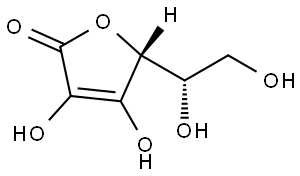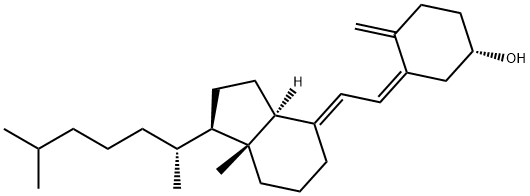Ascorbic acid , USP30 , 50-81-7
Synonym(s):
Ascorbic Acid;Vitamin C;L(+)-Ascorbic Acid;LYAG;L -AA
CAS NO.:50-81-7
Empirical Formula: C6H8O6
Molecular Weight: 176.12
MDL number: MFCD03457784
EINECS: 200-066-2
| Pack Size | Price | Stock | Quantity |
| 100G | RMB94.40 | In Stock |
|
| 500G | RMB318.40 | In Stock |
|
| others | Enquire |
PRODUCT Properties
| Melting point: | 190-194 °C (dec.) |
| alpha | 20.5 º (c=10,H2O) |
| Boiling point: | 227.71°C (rough estimate) |
| Density | 1,65 g/cm3 |
| FEMA | 2109 | ASCORBIC ACID |
| refractive index | 21 ° (C=10, H2O) |
| storage temp. | Store at +5°C to +30°C. |
| solubility | H2O: 50 mg/mL at 20 °C, clear, nearly colorless |
| pka | 4.04, 11.7(at 25℃) |
| form | powder |
| color | white to slightly yellow |
| PH | 3.59(1 mM solution);3.04(10 mM solution);2.53(100 mM solution); |
| Odor | Odorless |
| PH Range | 1 - 2.5 |
| optical activity | [α]25/D 19.0 to 23.0°, c = 10% in H2O |
| biological source | synthetic (organic) |
| Odor Type | green |
| Water Solubility | 333 g/L (20 ºC) |
| Merck | 14,830 |
| BRN | 84272 |
| BCS Class | 1 |
| Stability: | Stable. May be weakly light or air sensitive. Incompatible with oxidizing agents, alkalies, iron, copper. |
| InChIKey | CIWBSHSKHKDKBQ-JLAZNSOCSA-N |
| LogP | -1.85 |
| CAS DataBase Reference | 50-81-7(CAS DataBase Reference) |
| NIST Chemistry Reference | L-Ascorbic acid(50-81-7) |
| EPA Substance Registry System | Ascorbic acid (50-81-7) |
| Absorption | cut-off at 306nm in H2O at 1M |
Description and Uses
Ascorbic acid, a water-soluble dietary supplement, is consumed by humans more than any other supplement. The name ascorbic means antiscurvy and denotes the ability of ascorbic to combat this disease. Vitamin C is the l-enantiomer of ascorbic acid. Ascorbic acid deficiency in humans results in the body’s inability to synthesize collagen, which is the most abundant protein in vertebrates.
vitamin C is a well-known anti-oxidant. Its effect on free-radical formation when topically applied to the skin by means of a cream has not been clearly established. The effectiveness of topical applications has been questioned due to vitamin C’s instability (it reacts with water and degrades). Some forms are said to have better stability in water systems. Synthetic analogues such as magnesium ascorbyl phosphate are among those considered more effective, as they tend to be more stable. When evaluating its ability to fight free-radical damage in light of its synergistic effect with vitamin e, vitamin C shines. As vitamin e reacts with a free radical, it, in turn, is damaged by the free radical it is fighting. Vitamin C comes in to repair the free-radical damage in vitamin e, allowing e to continue with its free-radical scavenging duties. Past research has indicated that high concentrations of topically applied vitamin C are photoprotective, and apparently the vitamin preparation used in these studies resisted soap and water, washing, or rubbing for three days. More current research has indicated that vitamin C does add protection against uVB damage when combined with uVB sunscreen chemicals. This would lead one to conclude that in combination with conventional sunscreen agents, vitamin C may allow for longer-lasting, broader sun protection. Again, the synergy between vitamins C and e can yield even better results, as apparently a combination of both provides very good protection from uVB damage. However, vitamin C appears to be significantly better than e at protecting against uVA damage. A further conclusion is that the combination of vitamins C, e, and sunscreen offers greater protection than the sum of the protection offered by any of the three ingredients acting alone. Vitamin C also acts as a collagen biosynthesis regulator. It is known to control intercellular colloidal substances such as collagen, and when formulated into the proper vehicles, can have a skin-lightening effect. Vitamin C is said to be able to help the body fortify against infectious conditions by strengthening the immune system. There is some evidence (although debated) that vitamin C can pass through the layers of the skin and promote healing in tissue damaged by burns or injury. It is found, therefore, in burn ointments and creams used for abrasions. Vitamin C is also popular in anti-aging products. Current studies indicate possible anti-inflammatory properties as well.
Safety
| Symbol(GHS) |   GHS02,GHS07 |
| Signal word | Warning |
| Hazard statements | H226-H319 |
| Precautionary statements | P210-P305+P351+P338-P370+P378 |
| Hazard Codes | |
| Risk Statements | |
| Safety Statements | 24/25-36-26 |
| WGK Germany | 1 |
| RTECS | CI7650000 |
| TSCA | Yes |
| HS Code | 29362700 |
| Hazardous Substances Data | 50-81-7(Hazardous Substances Data) |
| Toxicity | LD50 oral in rat: 11900mg/kg |



